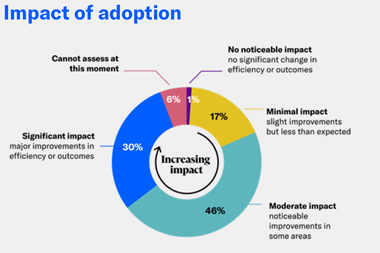The Government has asked industry to suggest new ways to take the risk out of pension funding. Adrian Leonard explores he alternatives.
When Robert Maxwell was caught with his hand in the pension cookie jar, the clear need for risk management measures in the area of occupational pensions - particularly in the case of employer insolvency - was thrust suddenly into the spotlight. The government responded by setting up the aptly-named Goode Committee, charged with the task of establishing security guidelines to ensure that UK pension funds were adequately funded to meet their commitments, even if the employer behind the scheme disappeared.
The Goode Committee concluded that members whose pension fund was wound up due to the sponsor's insolvency should receive exactly the same defined benefits as they would have, had the employer continued to fund the scheme. With that goal in mind, they proposed that a formula be prescribed and applied to measure funds' current assets against their future liabilities.
The Committee's 1993 recommendations were implemented in the Pensions Act 1995, through the establishment of the so-called Minimum Funding Requirement (MFR), which came into force in 1997. The MFR sets out relatively simple tests to ensure (in theory, at least) that pension funds accumulate assets which are sufficient and most likely to match their future liabilities, even if the employer becomes insolvent. Currently, the UK is home to about 38,000 defined benefit pension schemes subject to the MFR, and another 3,500 involving a mix of defined benefit and money purchase.
Can't get no satisfaction
Just four years on, almost no one is satisfied with the MFR, primarily because it tosses out the proverbial baby with the bath-water. It "is having serious, adverse consequences both for UK equity investment and for members of defined benefit pension schemes," declares the National Association of Pension Funds (NAPF). "Investment policy is increasingly constrained by trustee and employer concerns about the effects of a mismatch between MFR calculations and actual assets. In 20 years' time, there are likely to be more employees in the UK with inadequate pensions as a result of the MFR than there would have been without it. The MFR is having precisely the opposite effect to that intended - it is undermining the retirement provision of many members of defined benefit schemes." Implementation of the MFR showed up additional weaknesses, beyond its efficacy. It is, in effect, a risk management code for pension fund trustees. Very few of them have any investment expertise, so they tend to follow the safest course to meet the MFR. Notably, since UK government bonds are the MFR test's standard benchmark for calculating near-term liabilities (because investment risk is less tolerable as scheme members get close to or are in retirement), trustees tend to instruct their fund managers to buy substantial amounts of gilts to offset liabilities related to scheme members who are drawing their pensions, or are soon to do so.
Clearly, gilt assets are guaranteed to change in value at exactly the same rate as liabilities calculated against the value of gilts. Few trustees wish to take on the credit risk inherent in UK corporate bonds, let alone the additional burden of hedging currency risk, should they choose to invest abroad. Thus the MFR has driven huge demand for UK long bonds, and burgeoning budget surpluses make it increasingly less likely that new issues will ease the strain.
The most obvious symptom of the dissatisfaction is the rapid move from defined benefit to money purchase pension schemes, which fall outside the MFR and do not specify a return for pensioners. But the MFR has also caused more subtle, fundamental problems. In a government-sponsored review of the MFR published last year, the Pensions Board of the Faculty and Institute of Actuaries (F&IoA) found that it has led pension fund trustees to focus too much on short-term market conditions, and too little on long-term funding and investment policy.
A depressing tale
The F&IoA noted that the massive demand for long-term gilts may have contributed to the depression of UK bond yields, a sentiment which others have expressed with much greater force. Furthermore, MFR liability calculations relating to younger scheme members use dividend yield as a benchmark, but the F&IoA said that this is no longer a reliable measure of value for UK equities. "There is a large and worrying gap between the level of security which the MFR test delivers, and the public's perception of what it will deliver," the actuaries declared.
However, little more than further consultation has yet to result from their report. Despite the growing groundswell of discontent, it has taken a government enquiry into a completely different phenomenon for legislators to realise that the time had come to change the risk management protocols for pension funds.
In March 2000, the government launched the Myners Review of Institutional Investment, an investigation by Paul Myners, chairman of the Gartmore Fund Management Group, into the reasons behind governmentperceived under-investment in UK venture capital and private equity by pension funds. Mr Myners discovered that the government's own MFR was at the root of the problem. His interim recommendations suggest that the MFR be scrapped, and be replaced by a new solvency risk management procedure for UK pension schemes.
Scrap it
In his interim comments, Myners stated: "It is essential to have effective safeguards to ensure that members of defined benefit pension schemes can have confidence in the system. I do not believe that the MFR is such a safeguard. An effective alternative is needed. I propose instead that it should be replaced by an enhanced compensation scheme for fraud, mandatory arrangements for safe custody of pension fund assets [by removing company control over them], and transparency and independent review of pension funds' finances and plans." The actuaries disagree. They see the abandonment of testing, alongside the establishment of a compensation fund as an ineffective solution. "I don't think that will work," says Harvie Brown, chief actuary at William Mercer, the international benefits consultancy, and a former member of the Goode Committee. "Down the Myners route, the current MFR. would be scrapped, and we wouldn't have any test. Instead, it would all be done through disclosure." But, he says, companies on the ropes must be coerced into properly capitalising employees' pensions. "You need some sort of test, or people just won't fund pension schemes, at least not when times are tough. You can make companies reveal how [their pension schemes] are funded, but members' rights are still at risk." He does see flaws in the status quo. "The problem with the current system is that the test has become quite severe, because of market conditions, and because it tests future increases in liabilities accrued to date," he says. On the equities side, "changes in taxation and the distribution methods for company earnings have helped destroy the technical structure of the current MFR. Its continued application, without review, is now actually causing harm to the overall level of pension provision in the UK."
Fix it
William Mercer has put forward a proposal for a revised MFR. "It is a solid test of benefits based on peoples' salaries today, and the level of pensions today, with some additional voluntary funding requirement for salary or pension increases. It means testing is done on a current liability basis." That, Brown says, means employers and scheme members will be able easily to understand the investment assumptions behind their schemes.
Such a test would have to be based on gilt yields, the actuary says, as they are the most logical risk-free investment vehicle to give scheme members certainty that their pension, at today's values, is guaranteed. As for the Faculty and Institute itself, it says that if the MFR test is to survive in anything like its current form, liabilities for pensions in payment should be discounted using a composite index of gilts and corporate bonds, while liabilities for pensions not yet in payment should be discounted at the same rate plus 1%.
Kevin Adams, divisional director, government bonds, at Henderson Investments, sees the ongoing use of UK gilts by pension funds as an irreplaceable risk management tool, MFR or no MFR. "Even without it, pension funds' [members] are becoming more mature, so the actuarial consulting community would advise clients to buy more bonds anyway." Thus he believes scrapping the MFR would not have the serious effect some people might expect.
Invalid premise
The NAPF wants to scrap the MFR and bring on more actuaries. In its response to the consultation, the industry's trade association not only advocates the abolition of the MFR, but declares the whole concept of managing an ongoing pension fund to ensure the defined benefits of members in the case of the sponsor's insolvency to be invalid. They propose, instead, that members of an insolvent fund be transferred immediately to money purchase schemes such as a stakeholder pension, or choose to accept a scaled-down benefit. Not surprisingly, the NAPF recognises and accepts that a switch to money purchase transfers benefit risk to the fund member.
As for calculating minimum funding, the NAPF proposes that each scheme's actuary develop its own long-term funding formula - with guidance from the actuarial profession in the form of some general principles - and that actuaries assume a legal duty of care over scheme members to add accountability. Underfunded schemes would be required to top-up their reserves. The NAPF has also raised the spectre of Brussels: "The draft EC Directive on the Activities of Institutions for Occupational Retirement Provision requires schemes to maintain a certain level of funding." The NAPF thinks it essential that solvency and funding standards for UK schemes are not driven by Europe, and fully supports Paul Myners' conclusion that the current MFR should be abolished.
The solution may still be some way off. "We are going to have to sit on our hands for a time," said William Mercer's Harvie Brown. "Nothing will happen before the election, and thereafter, the new government will want some time to think. Then there will be a further period before legislation is passed and implemented. So it could be two years before we have something new in place."
--
Adrian Leonard is a freelance financial journalist
Protecting pensions: MFR in brief
The Minimum Funding Requirement (MFR) came into force in April 1997, with a ten-year phasing-in period. It sets a minimum level of assets for defined-benefit (final salary) pension schemes, and is intended to provide a reasonable level of security for members, should their employer go bust.
In theory, under the MFR a fully-funded pension scheme will have sufficient assets to meet its commitments to pensioners receiving payment, even' if their employer stops making contributions to the scheme. It is intended to give pre-retirement scheme members a "reasonable expectation" of gaining similar value from accrued pension funds if the employer shuts down and the member's funds are moved to another scheme.
The minimum requirement is calculated by comparing the market value of a fund to its liabilities.
Schemes which do not meet or just meet 100% funding on the MFR basis often opt to match their investments to reference assets used by the MFR to measure liabilities, so the two evolve in step. Since pensioners' liabilities are measured with reference to prevailing yields on UK gilts, funds are prone to buy gilts as the best-matching asset available. Liabilities for pro-retirement scheme members are based on the long-term dividend return from UK shares, and a combination of equity and gilt returns is used to value liabilities for pensioners ten or fewer years away from retirement.
In March 1999, the government asked the Pensions Board of the Faculty and Institute of Actuaries to review the MFR. In September 2000, apparently prompted by Paul Myners' report on pension funds' low investment in venture capital projects, the Secretary of State for Social Security published Security for Occupational Pensions, a consultation document describing encouraging alternatives to the MFR. Feedback was due by 31 January of this year.
The National Association of Pension Funds has advised the government that the MFR makes pension fund trustees too risk averse for pensioners' own good. They add that they believe there to be an inherent conflict between the MFR, which imposes the risk of short term fluctuations in funding requirements, and the long term allocation of assets to produce the best (financial) results for pension fund members."



















